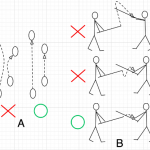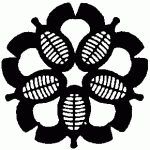Summary of class 1, 15/12Samenvatting les 1, 15/12
This summary is for the Almere group, who practice in the morning.
It’s great to see how our group keeps growing with newbies, who also show great attendance. Sadly, we don’t seem to have much luck with the guys in bogu. On the one hand lenience on attendance is part of the friendly atmosphere of our Almere dojo, but on the other hand it does keep ourselves and our juniors from learning as quickly as we could. We will certainly strive to improve attendance in 2013.
When it comes to our members, it’s also interesting to see how many young kids we attract. We don’t yet rival our mother-dojo in Amstelveen (who have flocks of Japanese children attending training on saturday), but with five under-ten year olds and numerous teenagers we’re certainly a young group.
Now, on to class. After warming-up we started with lunges in order to improve footwork and balance. There are two commonly made mistakes: either you keep a too-narrow stance and can’t keep your balance, or you over-compensate for that and take a too-wide stance (as per graphic A above). Kris-fukushou reminds us that we really should keep our feet at the proper width during the whole practice. Move in straight lines.
We practiced kihon in the motodachi system, with the eight guys in bogu acting as partner for the fourteen or so people without bogu. After that the group was split up as usual and my group moved on to waza practice. The two most important lessons for myself were about debana kote and suriage men.
With debana kote I was always confused: do I need to move my shinai over or under my opponent’s blade? Turns out that it’s neither, because both are too slow :) As per graphic B, Kris explained that your shinai stays almost level, while the opponent moves in for amen-strike. That way you automatically duck under his shinai and you also stay close enough for a quick kote strike.
Now, suriage men is apparently a very difficult technique for kyu-grade students, but it doesn’t hurt to get introduced. Kris-fukushou suggested the D/C-shaped movement that is also mentioned by Salmon-sensei in the linked article. And as Salmon-sensei points out, most of us were having lots of issues with both the movements and the timing. In my case I feel way too slow and I have it in my mind suriage men is a two-stage movement, while it should be more of a single arc where you deflect and strike from the deflect position.
Class was closed with all student in bogu acting as motodachi in uchikomi geiko, which the other students had to run twice. That meant a total of fourteen rounds of five strikes for everyone. A great way to close this last class of the year!
Sorry, er is helaas nog geen Nederlandse vertaling van dit bericht. Excuses voor het ongemak!


